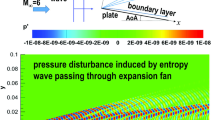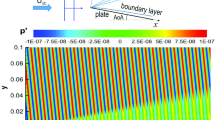Abstract
Transition prediction of the supersonic boundary layer on a cone with small angle of attack and Mach number 3.5 is investigated under the consideration of receptivity to slow acoustic waves, as the acoustic waves are the main environmental disturbances in a conventional, i.e. non-quiet, wind tunnel. It is shown that the e-N method can still yield fairly satisfactory results in comparison with those obtained in wind tunnel experiments, provided that the boundary layer receptivity to slow acoustic waves is properly taken into account, including the dependence of the amplitude of disturbances on the frequency and stream-wise location. Neither the conventional e-N method nor the improved e-N method can yield correct result of transition prediction, because the receptivity mechanisms considered there are not in accord with the real situation in the wind tunnel.
Similar content being viewed by others
References
Cebeci T, Stewartson K. On stability and transition in three-dimensional flows. AIAA J, 1980, 18(4): 398–405
Cebeci T, Shao J P, Chen H H, et al. The preferred approach for calculating transition by stability theory. In: Proceedings of International Conference on Boundary and Interior Layers. France: Toulouse, 2004
Crouch J D, Kosorygin V S, Ng L L. Modeling the effects of steps on boundary-layer transition. In: Proceedings of the sixth IUTAM Symposium on Laminar-Turbulent Transition. India: Bangalore, 2004
Su C H, Zhou H. Transition prediction of a hypersonic boundary layer over a cone at small angle of attack-with the improvement of e-N method. Sci China Ser G-Phys Mech Astron, 2009, 52: 115–123
Su C H, Zhou H. Transition prediction for supersonic and hypersonic boundary layers on a cone with angle of attack. Sci China Ser G-Phys Mech Astron, 2009, 52: 1223–1232
Ma Y B, Zhong X L. Receptivity of a supersonic boundary layer over a flat plate. Part 1. Wave structures and interactions. J Fluid Mech, 2003, 488: 31–78
Ma Y B, Zhong X L. Receptivity of a supersonic boundary layer over a flat plate. Part 2. Receptivity to free-stream sound. J Fluid Mech, 2003, 488: 79–121
Ma Y B, Zhong X L. Receptivity of a supersonic boundary layer over a flat plate. Part 3. Effects of different types of free-stream disturbances. J Fluid Mech, 2005, 532: 63–109
Zhong X L, Ma Y B. Boundary-layer receptivity of mach 7.99 flow over a blunt cone to free-stream acoustic waves. J Fluid Mech, 2006, 556: 55–103
Balakumar P. Receptivity of a supersonic boundary layer to acoustic disturbances. AIAA J, 2009, 47: 1069–1078
Pate S R. Measurements and correlation of transition Reynolds numbers on sharp slender cones at high speeds. AIAA J, 1971, 9: 1082–1090
Pate S R, Scheuler C J. Effects of radiated aerodynamic noise effects on boundary-layer transition in supersonic and hypersonic wind tunnels. AIAA J, 1969, 7: 450–457
King R A. Three-dimensional boundary-layer transition on a cone at mach 3.5. Exp Fluids, 1992, 13: 305–314
Mack L M. Stability of transition prediction in three-dimensional boundary layers on swept wings at transonic speeds. In: Proceedings of IUTAM Symposium III. Toulouse: Springer, 1988
Stetson K F, Thompson E R. On hypersonic transition testing and prediction. AIAA Paper, 1988, AIAA-88-2007
Kendall J M. Wind tunnel experiments relating to supersonic and hypersonic boundary layer transition. AIAA Paper, 1974, AIAA-74-133
Beckwith I E, Creel T R Jr, Chen F J, et al. Freestream noise and transition measurements on a cone in a mach 3.5 pilot low-disturbance tunnel. NASA Technical Paper 2180, 1983
Chen F J, Beckwith I E, Creel T R Jr. Correlations of supersonic boundary-layer transition on cones including effects of large axial variations in wind-tunnel noise. NASA Technical Paper 2229, 1984
Chen F J, Malik M R. Boundary-layer transition on a cone and flat plate at mach 3.5. AIAA J, 1989, 27: 687–693
Author information
Authors and Affiliations
Corresponding author
Additional information
Contributed by ZHOU Heng (CAS Academician)
Rights and permissions
About this article
Cite this article
Su, C., Zhou, H. Transition prediction of the supersonic boundary layer on a cone under the consideration of receptivity to slow acoustic waves. Sci. China Phys. Mech. Astron. 54, 1875 (2011). https://doi.org/10.1007/s11433-011-4472-0
Received:
Accepted:
Published:
DOI: https://doi.org/10.1007/s11433-011-4472-0




